Wafer Process工艺制造流程
- 格式:pdf
- 大小:666.98 KB
- 文档页数:23
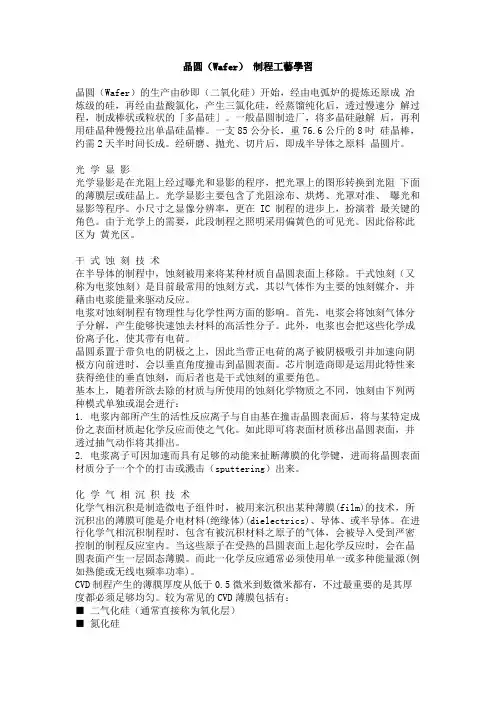
晶圆(Wafer)制程工藝學習晶圆(Wafer)的生产由砂即(二氧化硅)开始,经由电弧炉的提炼还原成冶炼级的硅,再经由盐酸氯化,产生三氯化硅,经蒸馏纯化后,透过慢速分解过程,制成棒状或粒状的「多晶硅」。
一般晶圆制造厂,将多晶硅融解后,再利用硅晶种慢慢拉出单晶硅晶棒。
一支85公分长,重76.6公斤的8吋硅晶棒,约需2天半时间长成。
经研磨、拋光、切片后,即成半导体之原料晶圆片。
光学显影光学显影是在光阻上经过曝光和显影的程序,把光罩上的图形转换到光阻下面的薄膜层或硅晶上。
光学显影主要包含了光阻涂布、烘烤、光罩对准、曝光和显影等程序。
小尺寸之显像分辨率,更在 IC 制程的进步上,扮演着最关键的角色。
由于光学上的需要,此段制程之照明采用偏黄色的可见光。
因此俗称此区为黄光区。
干式蚀刻技术在半导体的制程中,蚀刻被用来将某种材质自晶圆表面上移除。
干式蚀刻(又称为电浆蚀刻)是目前最常用的蚀刻方式,其以气体作为主要的蚀刻媒介,并藉由电浆能量来驱动反应。
电浆对蚀刻制程有物理性与化学性两方面的影响。
首先,电浆会将蚀刻气体分子分解,产生能够快速蚀去材料的高活性分子。
此外,电浆也会把这些化学成份离子化,使其带有电荷。
晶圆系置于带负电的阴极之上,因此当带正电荷的离子被阴极吸引并加速向阴极方向前进时,会以垂直角度撞击到晶圆表面。
芯片制造商即是运用此特性来获得绝佳的垂直蚀刻,而后者也是干式蚀刻的重要角色。
基本上,随着所欲去除的材质与所使用的蚀刻化学物质之不同,蚀刻由下列两种模式单独或混会进行:1. 电浆内部所产生的活性反应离子与自由基在撞击晶圆表面后,将与某特定成份之表面材质起化学反应而使之气化。
如此即可将表面材质移出晶圆表面,并透过抽气动作将其排出。
2. 电浆离子可因加速而具有足够的动能来扯断薄膜的化学键,进而将晶圆表面材质分子一个个的打击或溅击(sputtering)出来。
化学气相沉积技术化学气相沉积是制造微电子组件时,被用来沉积出某种薄膜(film)的技术,所沉积出的薄膜可能是介电材料(绝缘体)(dielectrics)、导体、或半导体。
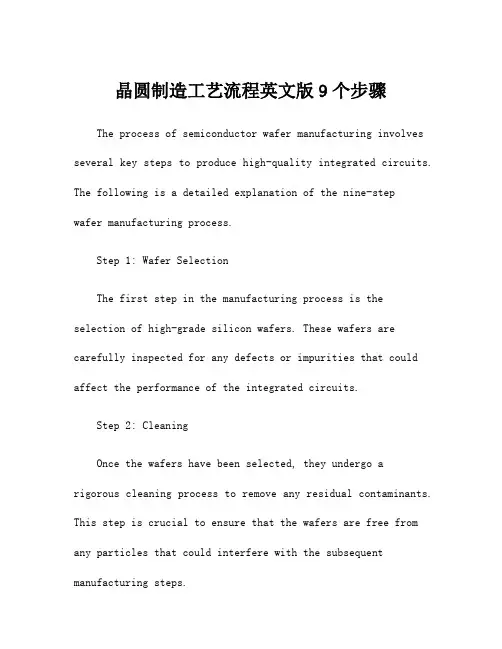
晶圆制造工艺流程英文版9个步骤The process of semiconductor wafer manufacturing involves several key steps to produce high-quality integrated circuits. The following is a detailed explanation of the nine-stepwafer manufacturing process.Step 1: Wafer SelectionThe first step in the manufacturing process is the selection of high-grade silicon wafers. These wafers are carefully inspected for any defects or impurities that could affect the performance of the integrated circuits.Step 2: CleaningOnce the wafers have been selected, they undergo arigorous cleaning process to remove any residual contaminants. This step is crucial to ensure that the wafers are free from any particles that could interfere with the subsequent manufacturing steps.Step 3: Photoresist CoatingAfter the cleaning process, a photoresist material is coated onto the wafers. This material is sensitive to light and is used to transfer the circuit patterns onto the wafers.Step 4: ExposureThe coated wafers are then exposed to ultraviolet light through a mask that contains the desired circuit patterns. This process transfers the patterns onto the photoresist material, creating a template for the circuitry.Step 5: DevelopmentThe exposed wafers are submerged in a developer solution, which removes the unexposed photoresist material. This step reveals the circuit patterns on the wafers, which will serve as a guide for the subsequent etching process.Step 6: EtchingThe wafers undergo a chemical etching process to remove the exposed silicon material, creating the actual circuit patterns on the surface of the wafers.Step 7: DopingDoping is the process of introducing impurities into the silicon to alter its electrical properties. This step is crucial for creating the necessary components, such as transistors, on the integrated circuits.Step 8: MetallizationOnce the circuit patterns have been defined, a thin layer of metal is deposited onto the surface of the wafers. This metal layer serves as the interconnects for the integrated circuits, allowing for electrical signals to pass between components.Step 9: Testing and PackagingThe final step in the manufacturing process involves testing the completed wafers for quality and functionality. Once the wafers have been tested, they are cut intoindividual chips and packaged for distribution to electronics manufacturers.In conclusion, the semiconductor wafer manufacturing process is a complex series of steps that are carefully orchestrated to produce high-quality integrated circuits. Each step plays a crucial role in defining the circuit patterns and ensuring the functionality of the final product.。
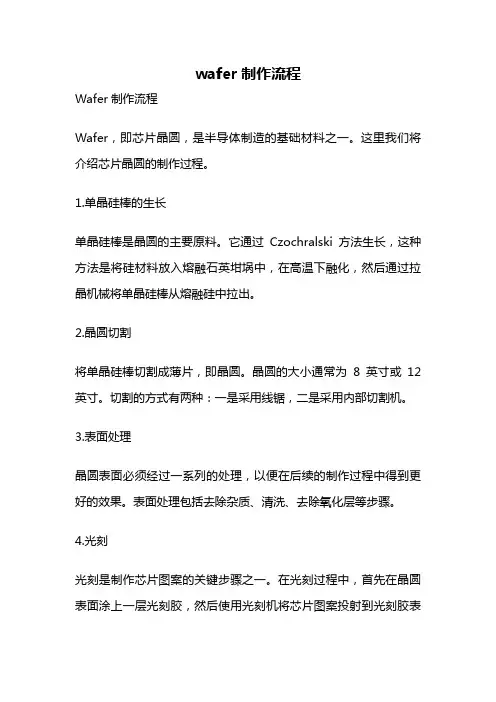
wafer制作流程
Wafer制作流程
Wafer,即芯片晶圆,是半导体制造的基础材料之一。
这里我们将介绍芯片晶圆的制作过程。
1.单晶硅棒的生长
单晶硅棒是晶圆的主要原料。
它通过Czochralski方法生长,这种方法是将硅材料放入熔融石英坩埚中,在高温下融化,然后通过拉晶机械将单晶硅棒从熔融硅中拉出。
2.晶圆切割
将单晶硅棒切割成薄片,即晶圆。
晶圆的大小通常为8英寸或12英寸。
切割的方式有两种:一是采用线锯,二是采用内部切割机。
3.表面处理
晶圆表面必须经过一系列的处理,以便在后续的制作过程中得到更好的效果。
表面处理包括去除杂质、清洗、去除氧化层等步骤。
4.光刻
光刻是制作芯片图案的关键步骤之一。
在光刻过程中,首先在晶圆表面涂上一层光刻胶,然后使用光刻机将芯片图案投射到光刻胶表
面,形成图案。
5.蚀刻
蚀刻是将光刻胶保护的区域去除,以便在后续的步骤中得到所需的图案。
蚀刻液通常是一种强酸,可以溶解掉不需要的部分。
6.沉积
沉积是在晶圆表面沉积一层化学物质。
如沉积一层金属用于制作导线,沉积一层二氧化硅用于制作绝缘层。
7.退火
退火是将晶圆加热到高温,以消除应力和提高晶体质量。
退火的温度和时间取决于晶圆的尺寸和用途。
8.包装测试
晶圆被切割成小芯片,并在芯片上进行测试和校准。
测试包括电气特性测试、可靠性测试、温度测试等。
以上就是Wafer制作的主要流程。
芯片制造需要高度的技术和设备,这也是为什么芯片制造业是高度发达的原因之一。
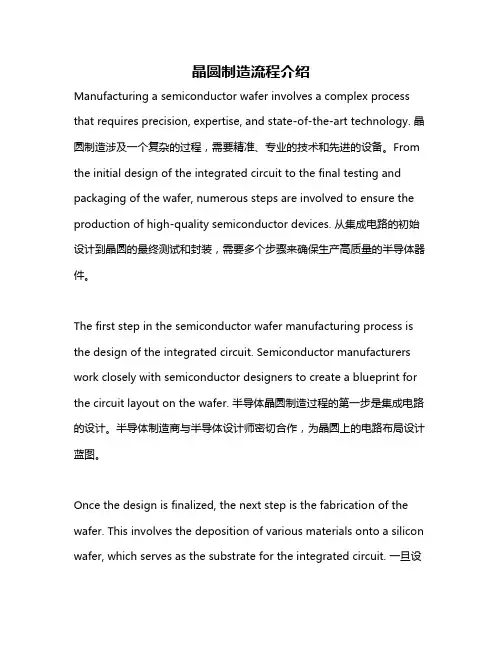
晶圆制造流程介绍Manufacturing a semiconductor wafer involves a complex process that requires precision, expertise, and state-of-the-art technology. 晶圆制造涉及一个复杂的过程,需要精准、专业的技术和先进的设备。
From the initial design of the integrated circuit to the final testing and packaging of the wafer, numerous steps are involved to ensure the production of high-quality semiconductor devices. 从集成电路的初始设计到晶圆的最终测试和封装,需要多个步骤来确保生产高质量的半导体器件。
The first step in the semiconductor wafer manufacturing process is the design of the integrated circuit. Semiconductor manufacturers work closely with semiconductor designers to create a blueprint for the circuit layout on the wafer. 半导体晶圆制造过程的第一步是集成电路的设计。
半导体制造商与半导体设计师密切合作,为晶圆上的电路布局设计蓝图。
Once the design is finalized, the next step is the fabrication of the wafer. This involves the deposition of various materials onto a silicon wafer, which serves as the substrate for the integrated circuit. 一旦设计完成,下一步是晶圆的制作。
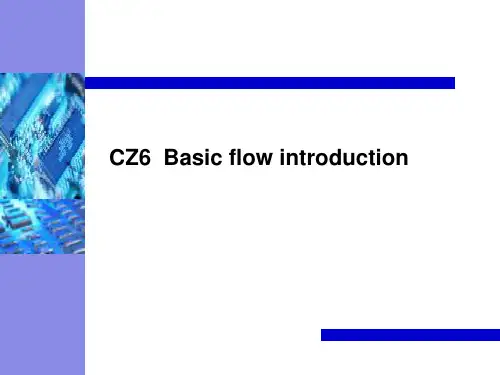
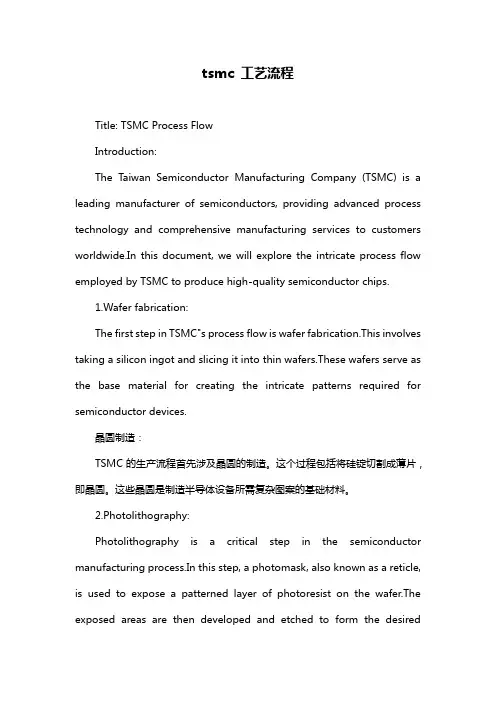
tsmc 工艺流程Title: TSMC Process FlowIntroduction:The Taiwan Semiconductor Manufacturing Company (TSMC) is a leading manufacturer of semiconductors, providing advanced process technology and comprehensive manufacturing services to customers worldwide.In this document, we will explore the intricate process flow employed by TSMC to produce high-quality semiconductor chips.1.Wafer fabrication:The first step in TSMC"s process flow is wafer fabrication.This involves taking a silicon ingot and slicing it into thin wafers.These wafers serve as the base material for creating the intricate patterns required for semiconductor devices.晶圆制造:TSMC的生产流程首先涉及晶圆的制造。
这个过程包括将硅锭切割成薄片,即晶圆。
这些晶圆是制造半导体设备所需复杂图案的基础材料。
2.Photolithography:Photolithography is a critical step in the semiconductor manufacturing process.In this step, a photomask, also known as a reticle, is used to expose a patterned layer of photoresist on the wafer.The exposed areas are then developed and etched to form the desiredpatterns.光刻技术:在半导体制造过程中,光刻技术是一个关键步骤。
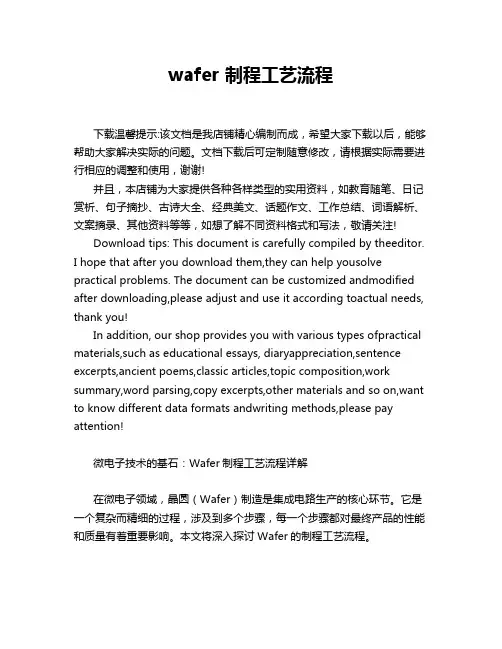
wafer 制程工艺流程下载温馨提示:该文档是我店铺精心编制而成,希望大家下载以后,能够帮助大家解决实际的问题。
文档下载后可定制随意修改,请根据实际需要进行相应的调整和使用,谢谢!并且,本店铺为大家提供各种各样类型的实用资料,如教育随笔、日记赏析、句子摘抄、古诗大全、经典美文、话题作文、工作总结、词语解析、文案摘录、其他资料等等,如想了解不同资料格式和写法,敬请关注!Download tips: This document is carefully compiled by theeditor.I hope that after you download them,they can help yousolve practical problems. The document can be customized andmodified after downloading,please adjust and use it according toactual needs, thank you!In addition, our shop provides you with various types ofpractical materials,such as educational essays, diaryappreciation,sentence excerpts,ancient poems,classic articles,topic composition,work summary,word parsing,copy excerpts,other materials and so on,want to know different data formats andwriting methods,please pay attention!微电子技术的基石:Wafer制程工艺流程详解在微电子领域,晶圆(Wafer)制造是集成电路生产的核心环节。
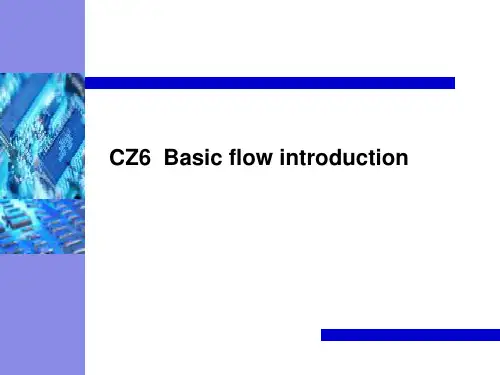
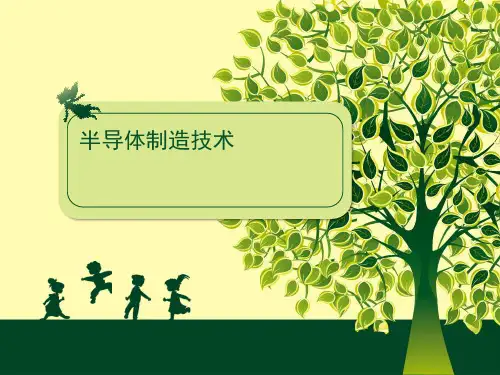
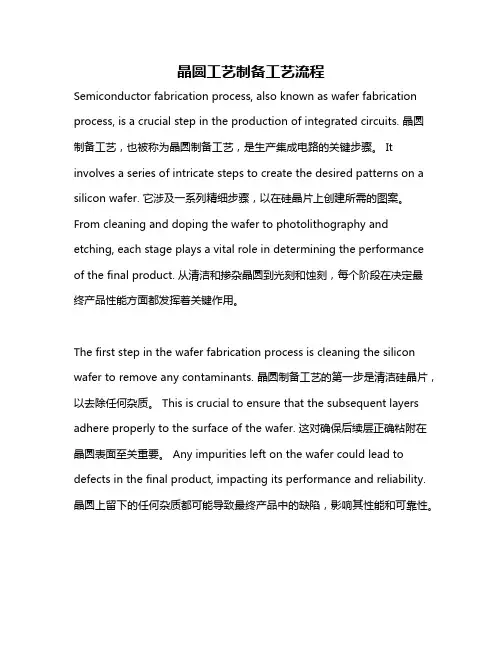
晶圆工艺制备工艺流程Semiconductor fabrication process, also known as wafer fabrication process, is a crucial step in the production of integrated circuits. 晶圆制备工艺,也被称为晶圆制备工艺,是生产集成电路的关键步骤。
It involves a series of intricate steps to create the desired patterns on a silicon wafer. 它涉及一系列精细步骤,以在硅晶片上创建所需的图案。
From cleaning and doping the wafer to photolithography and etching, each stage plays a vital role in determining the performance of the final product. 从清洁和掺杂晶圆到光刻和蚀刻,每个阶段在决定最终产品性能方面都发挥着关键作用。
The first step in the wafer fabrication process is cleaning the silicon wafer to remove any contaminants. 晶圆制备工艺的第一步是清洁硅晶片,以去除任何杂质。
This is crucial to ensure that the subsequent layers adhere properly to the surface of the wafer. 这对确保后续层正确粘附在晶圆表面至关重要。
Any impurities left on the wafer could lead to defects in the final product, impacting its performance and reliability. 晶圆上留下的任何杂质都可能导致最终产品中的缺陷,影响其性能和可靠性。
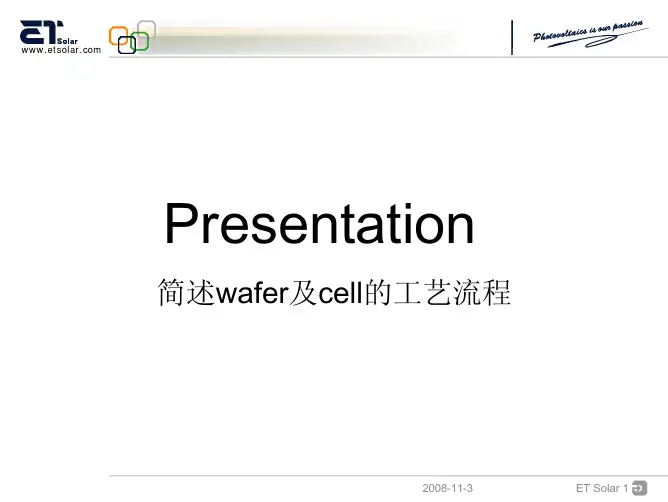
晶圆制备流程Semiconductor fabrication process, also known as wafer fabrication, involves a series of steps to create integrated circuits on semiconductor wafers. 晶圆制备流程,也称为晶圆制造,涉及一系列步骤,在半导体晶圆上创建集成电路。
These steps include cleaning, photolithography, etching, doping, and deposition, among others. 这些步骤包括清洁、光刻、刻蚀、掺杂和沉积等。
Each step is crucial in determining the quality and performance of the final semiconductor device. 每个步骤在决定最终半导体器件的质量和性能方面都至关重要。
Semiconductor fabrication is a complex and intricate process that requires precision and attention to detail at every stage. 晶圆制备是一个复杂而精细的过程,需要在每个阶段都进行精确和细致的关注。
The first step in semiconductor fabrication is cleaning the silicon wafers to remove any contaminants or particles. 半导体制备的第一步是清洁硅晶片,以去除任何污染物或颗粒。
This is typically done using a combination of chemicals and high-purity water to ensure the wafers are pristine and free of impurities before the next steps. 这通常是通过使用化学品和高纯水的组合来完成的,以确保晶圆在下一步骤之前是纯净的,没有杂质。
晶圆制造工艺流程1、表面清洗2、初次氧化3、CVD(Chemical Vapor deposition) 法沉积一层Si3N4 (Hot CVD 或LPCVD) 。
(1)常压CVD (Normal Pressure CVD)(2)低压CVD (Low Pressure CVD)(3)热CVD (Hot CVD)/(thermal CVD)(4)电浆增强CVD (Plasma Enhanced CVD)(5)MOCVD (Metal Organic CVD) & 分子磊晶成长(Molecular Beam Epitaxy)(6)外延生长法(LPE)4、涂敷光刻胶(1)光刻胶的涂敷(2)预烘(pre bake)(3)曝光(4)显影(5)后烘(post bake)(6)腐蚀(etching)(7)光刻胶的去除5、此处用干法氧化法将氮化硅去除6 、离子布植将硼离子(B+3) 透过SiO2 膜注入衬底,形成P 型阱7、去除光刻胶,放高温炉中进行退火处理8、用热磷酸去除氮化硅层,掺杂磷(P+5) 离子,形成N 型阱9、退火处理,然后用HF 去除SiO2 层10、干法氧化法生成一层SiO2 层,然后LPCVD 沉积一层氮化硅11、利用光刻技术和离子刻蚀技术,保留下栅隔离层上面的氮化硅层12、湿法氧化,生长未有氮化硅保护的SiO2 层,形成PN 之间的隔离区13、热磷酸去除氮化硅,然后用HF 溶液去除栅隔离层位置的SiO2 ,并重新生成品质更好的SiO2 薄膜, 作为栅极氧化层。
14、LPCVD 沉积多晶硅层,然后涂敷光阻进行光刻,以及等离子蚀刻技术,栅极结构,并氧化生成SiO2 保护层。
15、表面涂敷光阻,去除P 阱区的光阻,注入砷(As) 离子,形成NMOS 的源漏极。
用同样的方法,在N 阱区,注入B 离子形成PMOS 的源漏极。
16、利用PECVD 沉积一层无掺杂氧化层,保护元件,并进行退火处理。
晶圆剥离法工艺流程The process of wafer dicing, also known as wafer cleaving, is an essential step in semiconductor manufacturing. 晶圆剥离法是一种常用的晶圆分割方法,它是半导体制造的重要步骤之一。
This process involves the separation of individual semiconductor devices from a wafer, which is typically made of silicon. 这个过程涉及将单个半导体器件从硅晶圆中分离出来。
Wafer dicing is used to produce semiconductor devices such as integrated circuits, photovoltaic cells, and microelectromechanical systems. 晶圆剥离法用于生产集成电路、光伏电池和微机电系统等半导体器件。
There are several methods for wafer dicing, including mechanical scribing, laser scribing, and plasma etching. 晶圆切割有几种方法,包括机械划线、激光划线和等离子刻蚀。
One of the most common wafer dicing methods is the use of a mechanical saw to cut the wafer into individual devices. 其中最常见的晶圆切割方法之一是使用机械锯将晶圆切割成单个器件。
During this process, the wafer is mounted on a tape or film to prevent damage, and a high-precision saw is used to make the cuts. 在这个过程中,晶圆被安装在一种胶带或薄膜上以防止损坏,并且使用高精度锯进行切割。
PIE1. 何谓PIE? PIE的主要工作是什幺?答:Process Integration Engineer(工艺整合工程师), 主要工作是整合各部门的资源, 对工艺持续进行改善, 确保产品的良率(yield)稳定良好。
2. 200mm,300mm Wafer 代表何意义?答:8吋硅片(wafer)直径为 200mm , 直径为 300mm硅片即12吋.3. 目前中芯国际现有的三个工厂采用多少mm的硅片(wafer)工艺?未来北京的Fab4(四厂)采用多少mm的wafer工艺?答:当前1~3厂为200mm(8英寸)的wafer, 工艺水平已达0.13um工艺。
未来北京厂工艺wafer 将使用300mm(12英寸)。
4. 我们为何需要300mm?答:wafer size 变大,单一wafer 上的芯片数(chip)变多,单位成本降低200→300 面积增加2.25倍,芯片数目约增加2.5倍5. 所谓的0.13 um 的工艺能力(technology)代表的是什幺意义?答:是指工厂的工艺能力可以达到0.13 um的栅极线宽。
当栅极的线宽做的越小时,整个器件就可以变的越小,工作速度也越快。
6. 从0.35um->0.25um->0.18um->0.15um->0.13um 的technology改变又代表的是什幺意义?答:栅极线的宽(该尺寸的大小代表半导体工艺水平的高低)做的越小时,工艺的难度便相对提高。
从0.35um -> 0.25um -> 0.18um -> 0.15um -> 0.13um 代表着每一个阶段工艺能力的提升。
7. 一般的硅片(wafer)基材(substrate)可区分为N,P两种类型(type),何谓 N, P-type wafer?答:N-type wafer 是指掺杂 negative元素(5价电荷元素,例如:P、As)的硅片, P-type 的wafer 是指掺杂 positive 元素(3价电荷元素, 例如:B、In)的硅片。
晶圆制造的全制程详细流程步骤1.晶圆制造的第一步是原料的准备和筛选。
The first step in wafer manufacturing is the preparation and screening of raw materials.2.接着是将原料进行混合和研磨,以确保质地均匀。
Then the raw materials are mixed and ground to ensure uniform texture.3.混合研磨后的原料被压制成圆形块状。
The mixed and ground raw materials are compressed into circular blocks.4.圆形块状的原料经过高温高压处理,形成晶体结构。
The circular block of raw materials is processed at high temperature and high pressure to form a crystalline structure.5.接着是将晶体块状材料切割成薄片,形成晶圆的基础材料。
Then the crystalline block material is cut into thin slices to form the basic material for wafers.6.切割后的晶圆基础材料需要进行清洗和化学处理,以去除杂质和提高表面光洁度。
The cut wafer base material needs to be cleaned and chemically treated to remove impurities and improve surface smoothness.7.清洗处理后的晶圆基础材料需要进行光刻,将图形和结构转移到表面。
The cleaned and treated wafer base material needs to undergo photolithography to transfer patterns and structures onto the surface.8.光刻之后,晶圆基础材料被浸入化学溶液中进行腐蚀和刻蚀。
wafer加工工艺说起wafer 加工工艺,这可真是个精细又神奇的领域,就像一位巧匠在雕琢一件绝世珍宝!wafer 这小小的家伙,别看它个头不大,要把它加工成有用的宝贝,那可是要经历重重关卡,就像唐僧取经一样不容易。
首先是清洗环节,这就好比给刚出土的璞玉洗澡,得把表面的脏东西都弄干净,一点杂质都不能留。
要是洗得不干净,后面的工序可就都得乱套啦!然后是光刻,这一步就像是在 wafer 上画画,只不过这画笔可不是普通的笔,而是高科技的光刻机。
画的线条那叫一个精细,比头发丝还细好多倍呢!稍有差错,整个图案就全毁了,这可真是让人提心吊胆。
再说说蚀刻,这就像个小魔法师在 wafer 上施展魔法,把不需要的部分变没,只留下有用的图案。
这个魔法可得控制好力度,不然该留的不留,不该留的倒留了,那可就糟糕啦!沉积工艺也很关键,就像是给 wafer 穿上一层漂亮的衣服,这衣服得穿得均匀、结实,不然可保护不好里面的核心。
扩散和离子注入,这俩就像是给 wafer 注入能量和灵魂,让它拥有独特的性能和功能。
这过程就像是给运动员补充营养,得恰到好处,多了少了都不行。
研磨和切割,这简直就是给 wafer 做整形手术,得把它切成合适的大小和形状。
要是切歪了、磨坏了,前面的努力可就都白费啦!你说这 wafter 加工工艺是不是特别复杂又特别重要?每一步都得小心翼翼,就像走钢丝一样,容不得半点马虎。
经过这么多道工序,wafer 终于从一块普通的材料变成了高科技产品中的关键部件,是不是很神奇?这就像是丑小鸭变成了白天鹅,华丽转身!所以啊,别小看这小小的 wafer ,它背后的加工工艺那可是凝聚了无数科学家和工程师的智慧和心血。
咱们得好好珍惜这些高科技成果,不断去探索和创新,让 wafer 加工工艺更上一层楼!。